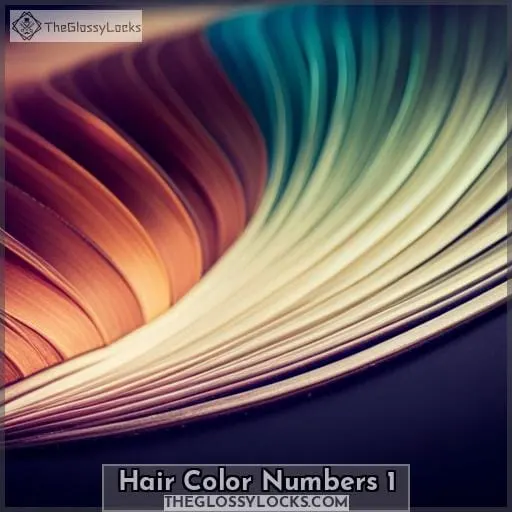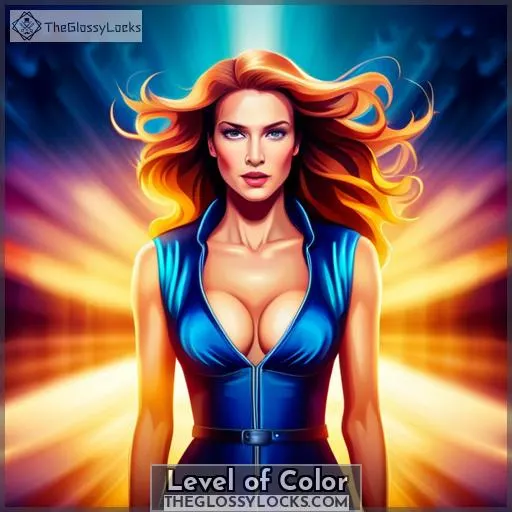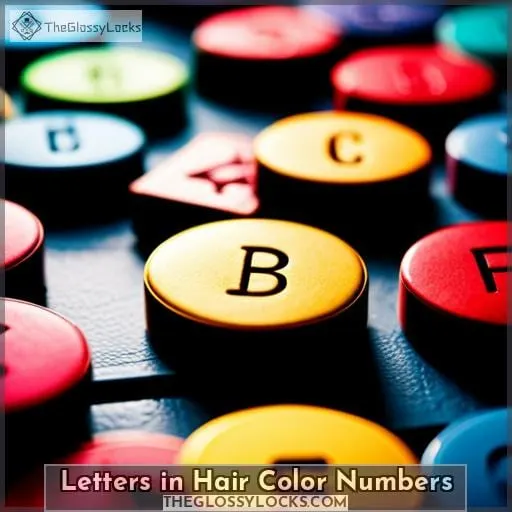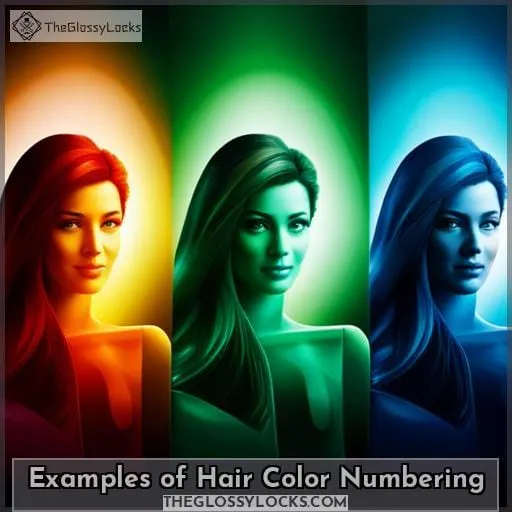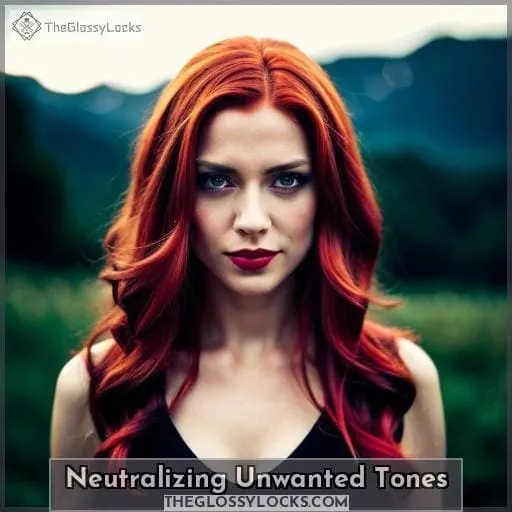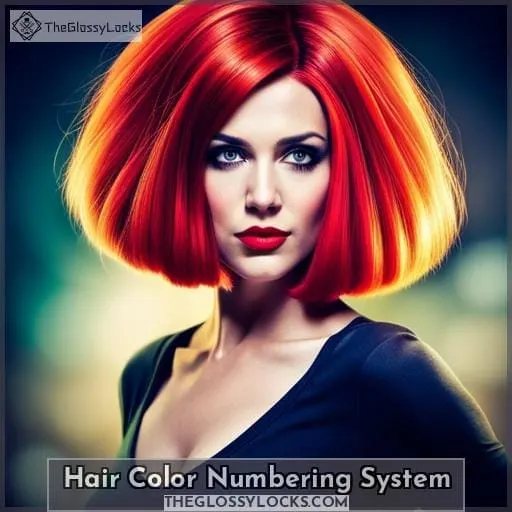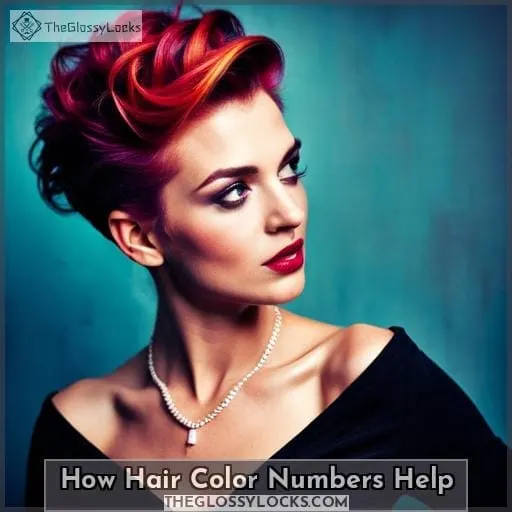This site is supported by our readers. We may earn a commission, at no cost to you, if you purchase through links.
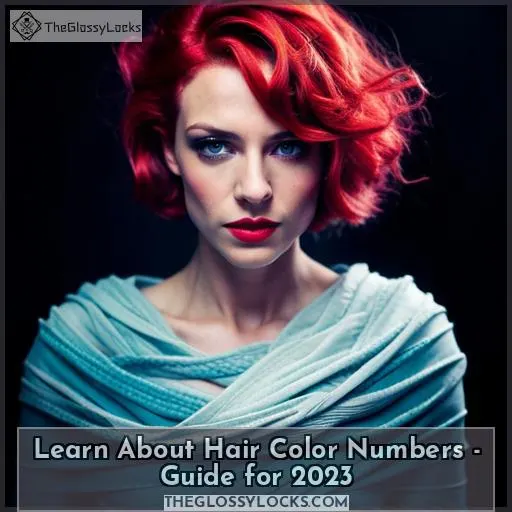 Do you ever find yourself feeling bewildered when it comes to understanding the hair color numbers? From 3.8 to 10.21, these figures are fundamental for making educated decisions about your locks and achieving that perfect shade in 2023! To help you make an informed decision, this guide will take a deep dive into understanding the elements of hair color number systems: level of color; shades & reflects; letters in numbers and neutralizing unwanted tones – all with examples along the way.
Do you ever find yourself feeling bewildered when it comes to understanding the hair color numbers? From 3.8 to 10.21, these figures are fundamental for making educated decisions about your locks and achieving that perfect shade in 2023! To help you make an informed decision, this guide will take a deep dive into understanding the elements of hair color number systems: level of color; shades & reflects; letters in numbers and neutralizing unwanted tones – all with examples along the way.
Table Of Contents
Key Takeaways
- Hair color numbers indicate the depth of the base color, with lower numbers representing darker shades and higher numbers representing lighter hues.
- Understanding the nuances of hair color numbers is essential for achieving desired results.
- Hair color numbers provide insight into achieving consistent results.
- The first digit or letter in the hair color number indicates the primary tone, while subsequent digits/letters refer to secondary tones that add reflectivity.
Understanding Hair Color Numbers
Understanding the various hair color levels, shades, and reflections can help you choose the perfect hue for your desired look. Hair dyes have numbers indicating the depth of their base color – lower numbers indicate darker shades while higher numbers refer to lighter hues.
Different brands may vary in their own numbering system with letters or decimals instead of a single number. Numbers after a decimal point are added tones that create deeper shades or secondary tints when mixed into the dye formulation.
It is important to understand these nuances for achieving desired results when coloring your hair.
The primary tone refers to the dominant hue in any given shade, while the secondary tone has less direct impact on the overall result but still affects it significantly.
If one desires intense colors, then duplicate numerals before the slash signify good coverage, whereas those after denote strong pigmentation respectively.
When selecting the right shade, remember that choosing wrong could lead to disastrous outcomes due to factors like individual skin type differences between products, etc.
Level of Color
You can use the hair color numbering system to chart your course towards a vibrant, lustrous look. The level of tone is the first step in this journey. The number indicates how light or dark the shade will be when applied and should always be considered before mixing colors.
A lower numbered base indicates darker tones, while higher numbers refer to lighter hues.
If you’re unsure which shades would work best together, then consulting a professional hairdresser is highly recommended. They have experience with numerous formulas and can provide valuable advice on what may suit you better than others.
The Color Wheel theory helps identify complementary colors that neutralize unwanted undertones by cooling warm ones and vice versa. It also assists in selecting special mix dyes whose purpose lies precisely within neutralization effects through choosing opposing pigments according to two rules found inside its famous circle diagram! Additionally, bleaching hair prior to the coloring process could become necessary depending on which hue/tone combination one desires from their chosen palette.
Some more intense variants require pre-lightening treatments beforehand due to their high pigment content levels. However, there are still ways around it even without such steps being taken, so don’t worry too much about that either.
Finally, understanding hair color numbers provides insight into achieving desired results consistently every time, regardless of individual skin type differences between products, etc. This makes them invaluable resources for any hairstylist looking to replicate specific hues accurately each time they come up against new clients with different requests coming from all directions.
So please do take note of all these details mentioned above because ultimately we want everyone’s locks looking beautiful and healthy, no matter what end goal was initially set out at the start point.
Color Shades & Reflects
Understanding the nuances of hair color numbers is essential for achieving desired results. Different shades and reflects can be identified using these numbers, such as the primary tone – which indicates the dominant hue – and secondary tones that have a less direct impact on your mane.
Knowing how to interpret these codes helps you pick out just the right shade or reflection for an amazing look! So let’s take a closer look at understanding hair color numbers and deciphering their secrets together.
Color Shade
Choosing the right shade is key to achieving your desired color outcome. Knowing how to read and interpret hair dye numbers, as well as understanding basic mixing techniques, will help you achieve a beautiful result every time.
Hair dye numbers indicate the depth of the base color: lower numbers indicate darker shades while higher numbers represent lighter tones.
The primary tone is indicated by letters or words such as natural, ash, copper, etc., whereas secondary reflections are usually represented by a number after a slash (e.
Additionally, it’s always beneficial to consult a professional hairdresser who can advise on which colors will best suit your needs and provide valuable advice on bleaching techniques for more intense hues or neutralizing unwanted undertones using complementary tones according to the Color Wheel theory.
Understanding hair color numbers provides insight into replicating desired results consistently every time; making them invaluable resources for any hairstylist looking to create vibrant looks!
Color Reflect
Learning about color reflections can help you create dynamic hairstyles. Many hair dye brands use a number after the slash to represent secondary tones. For example, duplicate numbers before the slash signify intense coverage for grey hairs, while single numbers without slashes denote neutral colors.
The Color Wheel theory can be used to identify complimentary tones and neutralize unwanted undertones in your chosen shade.
Understanding different tone variations is essential when creating a unique look with any type of hair dye formula.
Letters in Hair Color Numbers
Unlocking the mystery of hair color can be easy when you know how to interpret letters in its numerical codes. Different brands of hair color use letters instead of numbers to indicate the shade or reflection, such as ash tones, natural tones, and violet reflections.
Each brand has its own numbering system, so it is important to understand what each letter means in order for you to achieve your desired result. For example, a ‘C’ indicates Neutral Ash. This tone combines equal amounts of yellow, blue, and red, which are fundamental colors found on a color wheel that creates neutral shades like browns and blacks with an added cool undertone.
Combinations of numbers also help identify other types of warm or cool undertones, depending on if there is one number before the slash mark (indicating intense coverage) or two after (indicating an intense shade).
Understanding these various coding systems will enable you to have greater control over your look by creating precise blends based on different levels of lightness/darkness combined with accentuated reflections, all while avoiding unwanted hues from appearing when coloring your locks!
Knowing how to decipher between numbers and letters within hair dye formulas allows for more accurate outcomes since choosing wrong could lead to unsatisfactory results due to undesired pigments not being taken into account prior to the application process begins – making knowledge about interpreting both essential towards achieving beautiful end-looks no matter the type of hue chosen!
With the right information at your fingertips, even a novice dyer can confidently select the perfect combination that meets their individual needs without consulting a professional hairdresser beforehand, thus saving time and money during the whole experience overall.
Examples of Hair Color Numbering
Understanding the various hair color numbering systems can help you make informed decisions when selecting your desired shade, allowing for a precise blend of tones and reflections that create beautiful end-looks.
The primary tone is denoted by a single or double number before the slash mark, with higher numbers indicating lighter shades. The second number after the slash stands for secondary tones such as ash, natural, or violet.
Mixing colors from different brands according to their codes allows you to achieve unique looks while following basic rules of hair color:
- Neutralize warm tones with cool ones and vice versa using complementary colors on a color wheel.
- For intense coverage, use duplicate numbers before the slash.
- Single without any slashes denotes a neutral hue.
- Duplicate numbers after the slash signify an intense shade.
Bleaching is often required prior to coloring in order to achieve certain hues, which makes consulting professional hairdressers advisable if unsure about what one needs exactly – especially when attempting more intricate coloring techniques like balayage or ombre!
Hair dyes also have other letters added onto them, which represent additional intensive pigments found within specific formulas designed specifically towards counteracting grey hairs better than usual dye solutions would be able to otherwise!
Lastly, understanding hair color numbers helps replicate the desired result consistently while avoiding undesired undertones brought forth by incorrect choices made beforehand due to its universal reference system used across many beauty salons around the world today, providing both amateurs and experts alike greater control over their image’s final look whenever they want it.
Neutralizing Unwanted Tones
By utilizing complementary colors on the color wheel, you can easily neutralize warm tones with cool ones and vice versa to get your desired hair hue. Hair dyes often have various numbers and letters that indicate the depth of their base color.
Lower numbers usually mean darker shades, while higher ones indicate lighter shades. Added letters represent intensive pigments within a particular formula designed for counteracting grey hairs better than regular dye solutions would be able to otherwise.
For instance, Garnier Olia is a popular brand that uses ‘1’ as its darkest shade and gradually increases up until it reaches ’11’ – its lightest one available in their range of products! A single number without any slashes denotes a neutral shade, whereas duplicate numbers before or after signify more intense hues or coverage respectively.
This allows you to mix different brands based on their code labels for unique looks following fundamental rules from color theory.
In addition to understanding how many brands work according to these standards, it helps ensure results remain consistent when attempting something new every time – whether it be an ombre look or even balayage technique too! Knowing what each letter represents (i.
e., natural tone versus pure violet) additionally further simplifies the selection process by narrowing down options much faster than if relying solely upon visuals alone. This universal reference system is used across multiple beauty salons around the world today with minimal effort required overall from both ends involved throughout the entire process itself.
It makes sure all parties are satisfied with the end result achieved, no matter what happens beforehand during the journey there too. Thanks largely in part towards having such knowledge at your disposal whenever needed, most importantly so everything turns out just the way everyone wants it.
It is always guaranteed yet again, regardless of the situation facing headfirst every step of the way forward into the unknown future awaits.
Hair Color Numbering System
Understanding hair color numbers can be a daunting task. By familiarizing yourself with the numbering system, you will gain insight into how each number and letter reflects color tone and reflection.
Color Tone
You can use the hair color numbering system to determine the primary and secondary tones in a dye formula, which will create your desired hue. For example, adding violet tones into a mix can help neutralize yellowish undertones while ash/green colors counteract redness.
It’s important to understand how each brand works according to these standards in order to achieve consistent results when attempting something new every time.
Blending colors from different brands is possible with knowledge of their code labels following fundamental rules from color theory:
- Choose the right shade – lighter shades are recommended if you’re unsure
- Hair bleaching might be necessary before achieving certain hair colors
- Use the Color Wheel as a reference for complementary tone selection
- Duplicate numbers before the slash signify intense coverage for grey hairs
- Numbers after the slash denote the intensity or depth of that particular shade
Hair toners also come into play when seeking the perfect balance between the warmer undertone of the hair color and cooler highlights added on top! By understanding this numbering system thoroughly, you’ll be able to select just about any professional hairdressing brand available today without ever worrying about mixing up depths of base colors or getting confused by various number/letter combinations used instead! The outcome depends heavily upon factors like pH levels – it’s advisable to consult expert advice beforehand so as not to regret later on down the line either way.
Color Reflection
Knowing how to read the code labels of different brands can help you achieve accurate color reflections for your hair. Hair dyes indicate the level, shade, and reflection of a particular color by using numbers.
A higher number will typically indicate lighter shades, while lower numbers suggest darker colors.
The primary tone is indicated by the first digit or letter – with minor differences in some brands – while subsequent digits/letters refer to secondary tones that add reflectivity. Natural tones are often signified with an ‘N’ after a slash, whereas cool undertones are denoted as ‘0’.
Mastering this system requires knowledge of identifying tones, mixing colors according to principles from color theory, and consulting professional advice when needed for the best results! It’s also important to note that slight variations between each brand exist due to the indicator of color levels, which may require choosing a slightly lighter shade if unsure about the desired outcome!
With an understanding of how each formula works, plus familiarity in using tools like Color Wheels, you’ll be able to unlock more creativity when experimenting with alluring hues without worry!
How Hair Color Numbers Help
Hair color numbers can be a great tool for achieving desired results when formulating colors. Understanding hair color numbers helps in selecting the right shade of dye and getting the desired outcome.
With a better understanding of these numbers, you’ll be able to choose colors that suit your hair type and skin tone.
When it comes to choosing a particular shade, lower numbers indicate darker shades, while higher ones point towards lighter shades on the International Color Chart (ICC). This chart is used by professional hairdressers as an international reference system for selecting different hues of hair dyes.
After deciding upon the base color with its numeric value, additional tones or shades are indicated by the following number after a slash mark, like 8/3, which stands for a deep red copper blonde hue with golden reflections, respectively.
Similarly, letters such as ‘N’ stand for natural tones, which have no underlying pigments added to them, while ‘A’ stands for Ash-based pigmentation being present in them.
To make sure your chosen hue looks best on you, consulting a professional hairstylist is advisable before starting any bleaching process at home. Professional advice helps in making better-informed decisions about what would work best according to one’s own individual features, such as complexion, density, and porosity level, etc.
The use of complementary colors from opposite ends of the color wheel also ensures that unwanted undertones do not appear during or after application; cool colors neutralize warm ones and vice versa, depending on how much darkening or lightening needs to be done within each step taken forward towards the final result needed.
The knowledge gained through understanding the basic principles behind numbering systems employed within industry standards allows us to create accurate replicas required time and again without creating too many errors along the way, thus allowing us more control over our work than ever before possible! From carefully planning out processes involved ahead pertaining to every aspect related to the project, to learning tips and tricks necessary to gain confidence and carry out tasks correctly on the first try – it all boils down to mastering the art and science behind these seemingly complex yet very easy to understand once we get the hang of the basics provided here!
Frequently Asked Questions (FAQs)
How do I know which hair color number is right for me?
To determine the right hair color number for you, consider a case study of someone who successfully found their perfect shade. Evaluate their process and tailor it to your own needs: look at the tone, level, reflection, and undertones before selecting a hue that will make you feel powerful and liberated.
What are the risks associated with bleaching my hair?
Bleaching your hair comes with risks. It could cause scalp irritation, dryness, breakage, and fading color. Your hair may become brittle or fragile. You might experience discoloration or uneven results as well.
What is the difference between a primary and a secondary tone?
A primary tone is the dominant hue in the hair color, while a secondary tone has a less direct impact. Primary tones are often brighter and more vibrant than secondary ones. The combination of these two can create unique shades and reflections to achieve desired results.
Neutral colors contain equal amounts of yellow, blue, and red for natural-looking outcomes.
How do I keep my hair color looking its best?
Maintain your hair color’s vibrancy by using a sulfate-free shampoo and conditioner, washing every three to four days, reducing heat styling, and protecting hair from the sun. Deep conditioning treatments can help maintain moisture levels in colored locks, while regular trims will prevent split ends.
Seek professional advice if you want to switch up your shade or are considering bleaching for more drastic transformations.
Is it necessary to consult a professional hairdresser?
Yes, it is highly recommended to consult a professional hairdresser before coloring your hair. They can provide invaluable advice on choosing the right shade and ensuring desired results.
Conclusion
It is clear that hair color numbers are a valuable tool for hairstylists, providing a universal reference for hair coloring. Understanding hair color numbers helps to select the right shade and replicate desired results consistently.
It is essential to consider the level, shade, and reflection of the color when choosing a hair dye formula to achieve the desired result.

